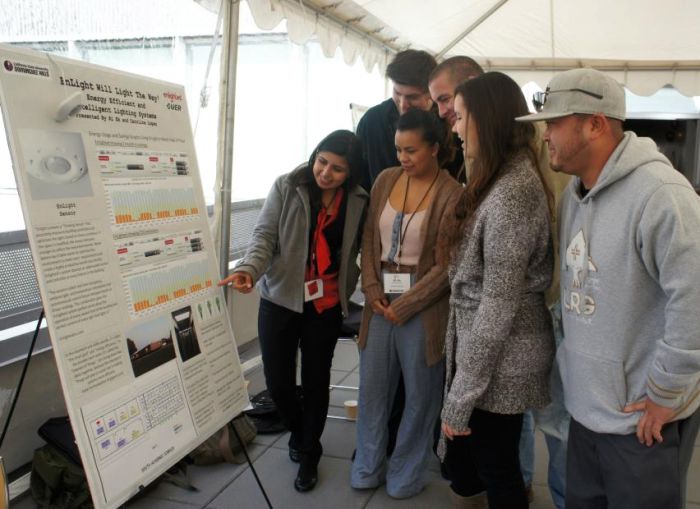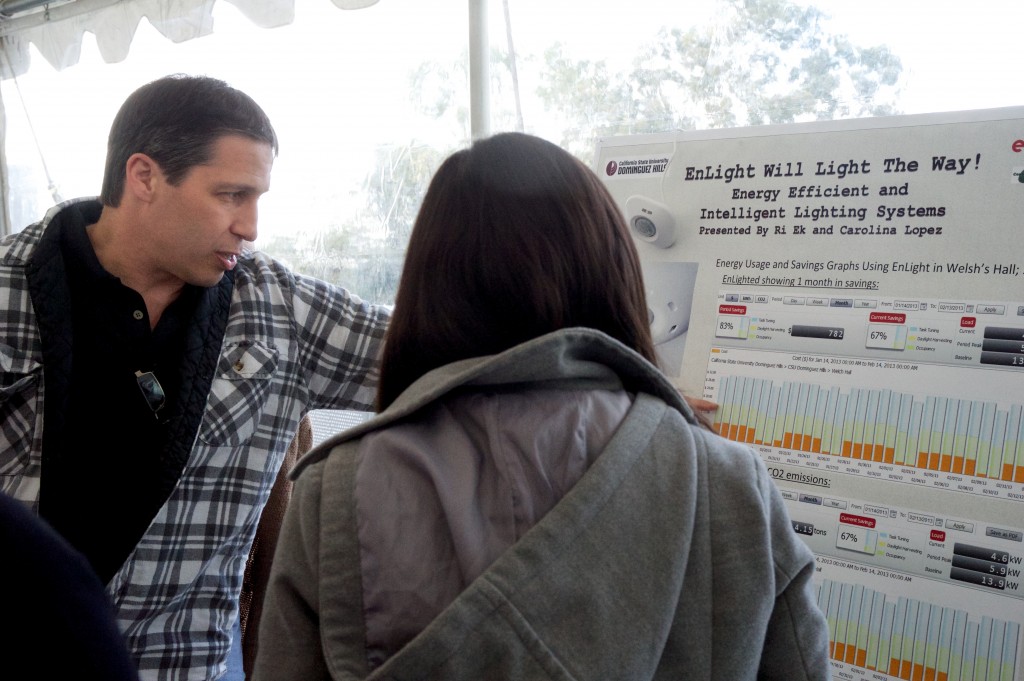“Turn off the light!”
Those who remember their parents calling out the admonition–and possibly their own respondent groan–likely know it was dispensed in an effort to save money when a room was unoccupied. In today’s strained economy, this frugal habit now reaches beyond the home–and comes with the added imperative of reducing environmental impact.

To that end, central plant and energy manager Kenny Seeton is leading a cost- and energy-saving lighting retrofit project at California State University, Dominguez Hills.
Anyone who has walked the corridors of Welch Hall since December–when a contract crew completed installation of 244 smart sensors in the hallways–will have noticed the change. Ceiling lights illuminate as a person approaches–as if the halls are happy to see them–and return to their dimmer setting after a brief period. The sensors were also installed in the Information Technology suites on the third floor and the Administration and Finance suite on the fourth floor of Welch Hall.
The retrofit came after Seeton and the Physical Plant team made an evaluation of the existing lighting system, conducted a two-month pilot project with three fixtures, and received the help of environmental science students from the university who researched several product options.
Whether formulating data into an analytical presentation, conducting comparative product research, or counting the lights in each building on campus, Seeton said students play a vital role in such projects.
“I mean, how long would it take to count all the lights in these buildings?” queried Seeton, who has worked with students on a broad range of projects that explore campus improvements–some theoretical and others that have been actualized.
Among the features that made a system by Enlighted Inc. the preferred match for the project, was that sensors could be installed into existing fixtures, rendering an upgrade a relatively simple and cost-effective process, according to Seeton and seniors Carolina Lopez, a geology major with an earth science option, and Ri Ek, a geology major with an earth and environment option who researched the company’s product.
The system is also intelligent. Smart sensors make lighting control decisions locally at the fixture, adjusting light levels by sending information via a wired connection to the ballast of the host fixture. Using a wireless infrastructure to gather and transport data to a web-based network, lighting can be remotely monitored and managed.
“This product can adjust the light level based on the task. Before, if anyone wanted less light in their office they took bulbs out of their fixtures,” Seeton said. “Instead of taking out bulbs and getting an uneven light, we can tune it down.”
The sensors also make real-time adjustments as natural light streams through windows and doors. During work hours when spaces are unoccupied, lamps in fixtures equipped with the smart sensors idle from zero to 10 percent luminosity until motion is detected.
“There’s power to fixtures in Welch Hall corridors from 7 a.m. to 7 p.m., but with the smart sensors instead of those lights being on at 100 percent, the highest they ever go is 40 percent. And you don’t notice it. …That’s how much we were over lit there,” Seeton said. “We couldn’t do that with just an occupancy sensor.”

Fixtures are set to automatically dim after inactivity–within a minute in retrofitted hallways–and ramp back up when motion is detected.
“When people see the light levels go up as they approach a space, they think, ‘Oh, we’re saving energy,’” he said. “That’s my goal.”
Leveraging what Lopez and Ek learned through their research project “Enlighted will Light the Way,” which they presented at Student Research Day in February, Seeton was able to persuade Enlighted to subsequently donate the materials to retrofit roughly 200 light fixtures in selected hallways, classrooms and offices in the South Academic Complex (SAC) II building. Approximately 50 have been installed so far.
Seeton estimates 159 hallway sensors save 3,270 kWh per month and projects energy savings for Welch Hall to be 73,846 kWh for the first year of operation, translating into 65 to 85 percent in energy costs for that area. With that in mind, he calculates the $55,000 investment for fixtures and labor to be recouped well within four years. Additionally, Edison is expected to issue a rebate of nearly $20,000 for the energy savings in Welch Hall.
Seeton considers a campus-wide lighting retrofit to be a “no-brainer.” And he’s not alone.
“Our project is important because it helps our school save money,” Ek said. “Light is money. Money is huge concern for the campus, as well as energy efficiency and setting an example for other universities.”
Through discussions held with directors and energy managers from the 23 CSU campuses during monthly online meetings, Seeton has discovered that while the University of Southern California; University of California, Santa Barbara; and CSU Channel Islands are following suit, CSU Dominguez Hills leads the way as an early adopter.
“From the people I’ve talked to, nobody has this extensive of a control system,” he said.
And Seeton has only begun to tap into what Enlighted can do.
“After I get it installed and adjust the light level and task-tune to individuals’ needs, then I’ll tie [Enlighted] into the heating and cooling system to save energy when nobody is in a space, especially for extended periods of time like semester breaks or vacation,” Seeton said. “With this technology, …I can adjust the thermostat from my computer.”
While many a parent may still be inclined, Seeton isn’t likely to call out, “Don’t touch the thermostat!”
University faculty, staff and students as well as Enlighted and Edison will be recognized for their contributions to the project and sustainability efforts during a ceremony on May 1 at 1 p.m. in the east hallway of SAC II.